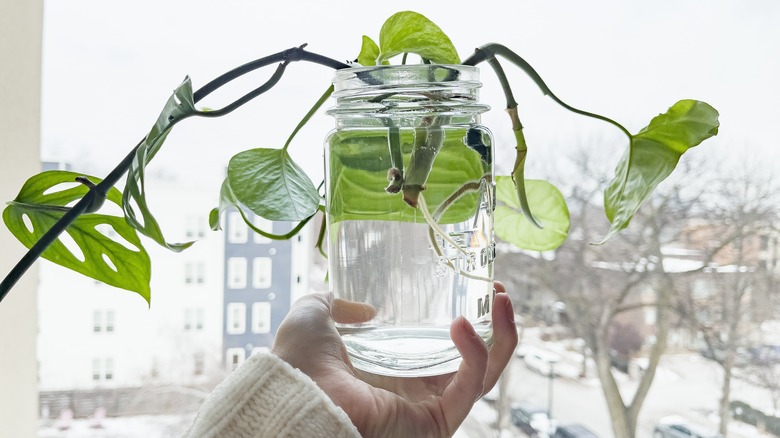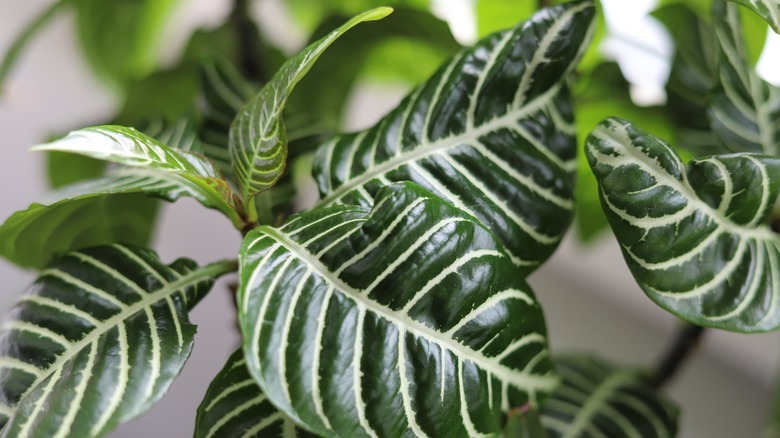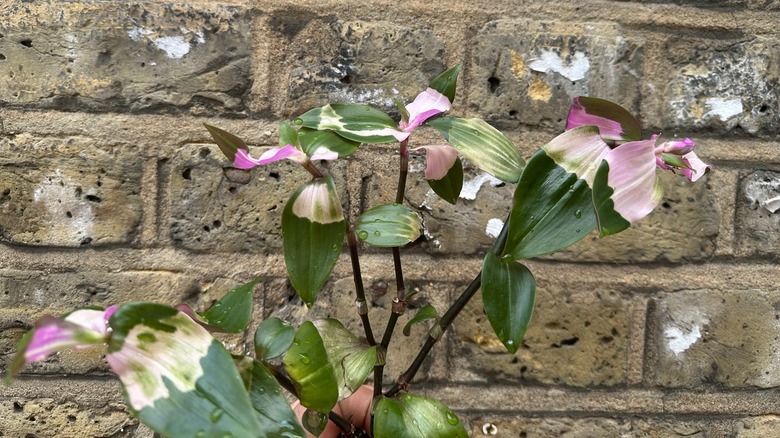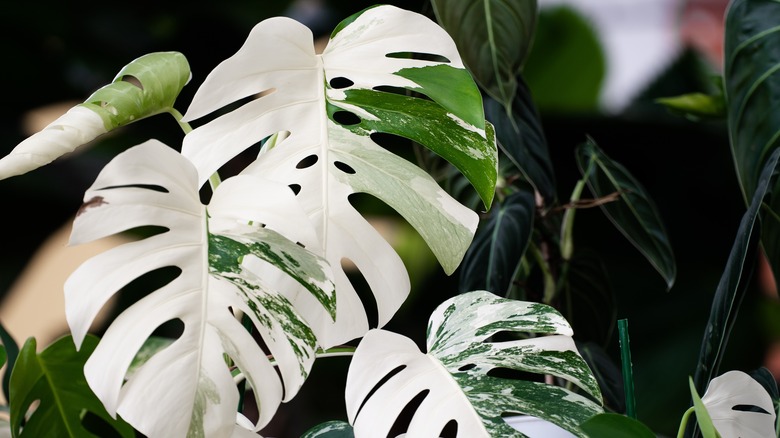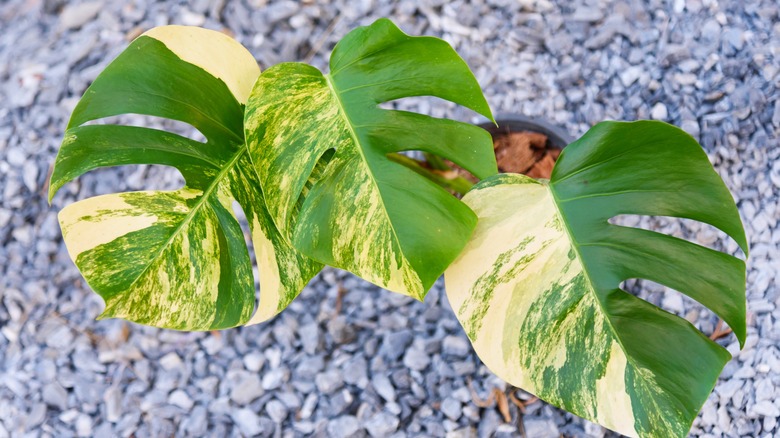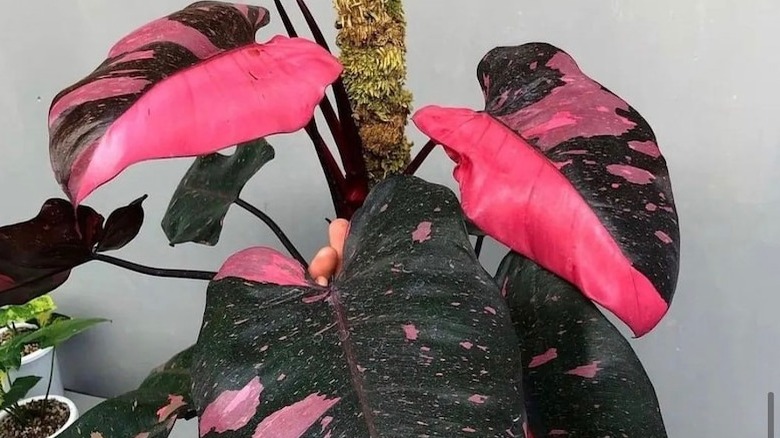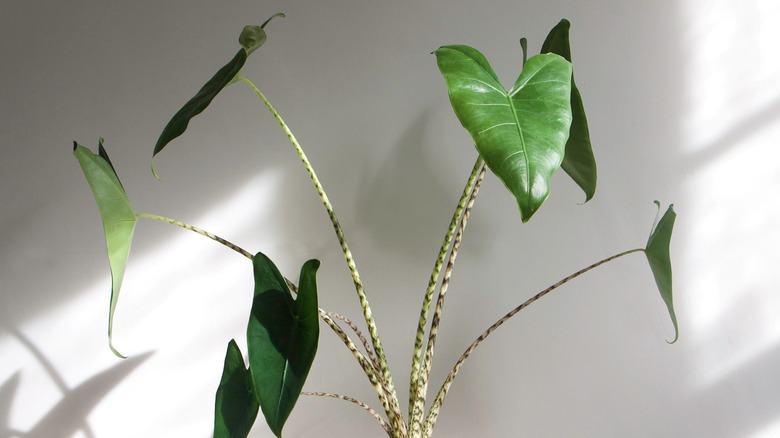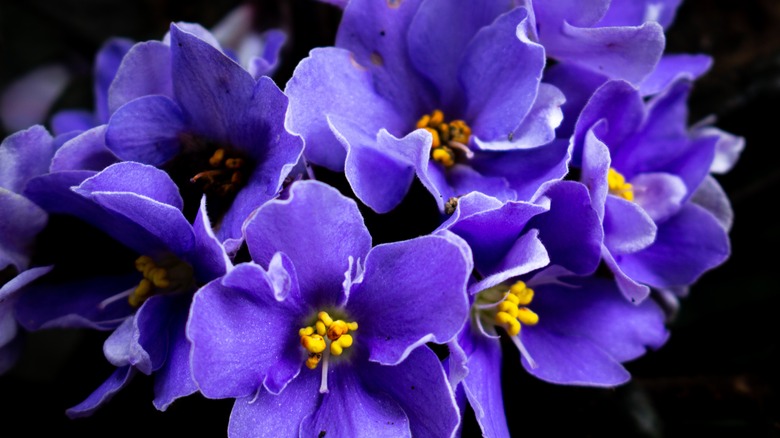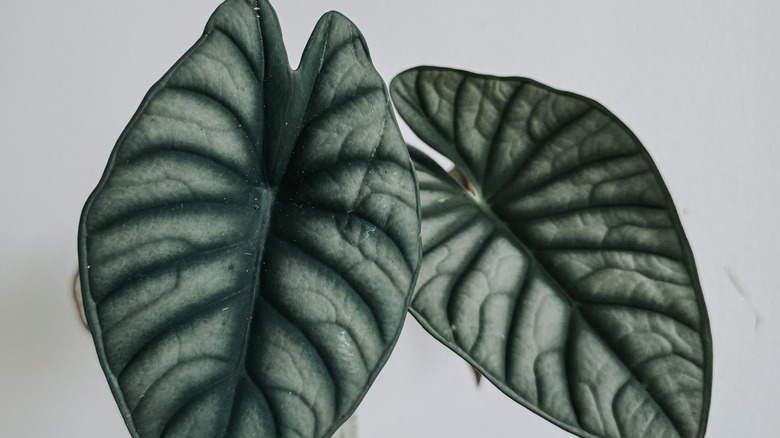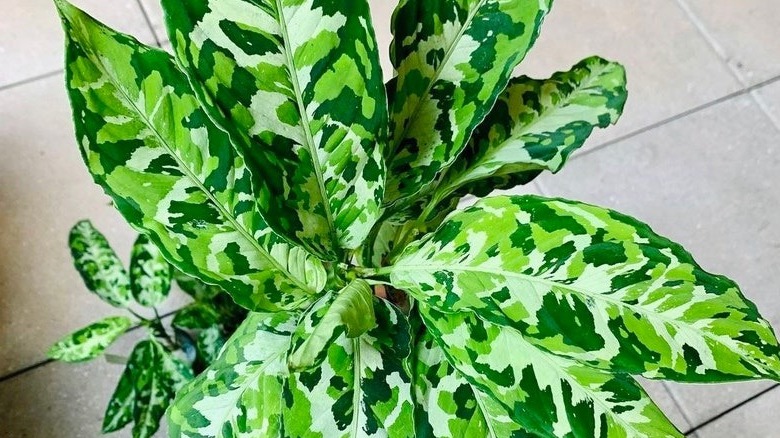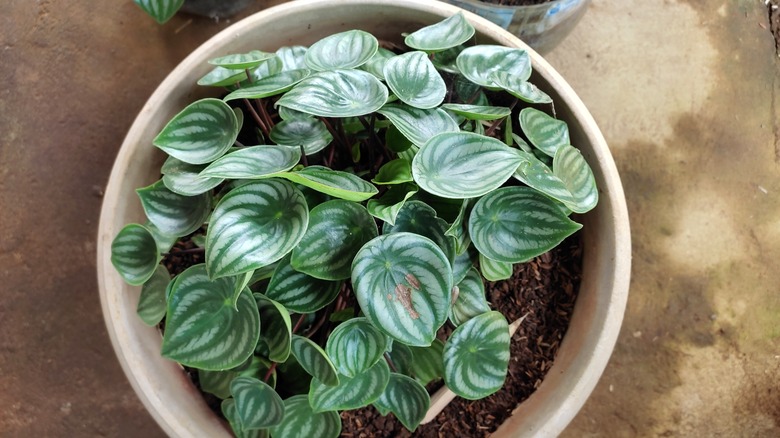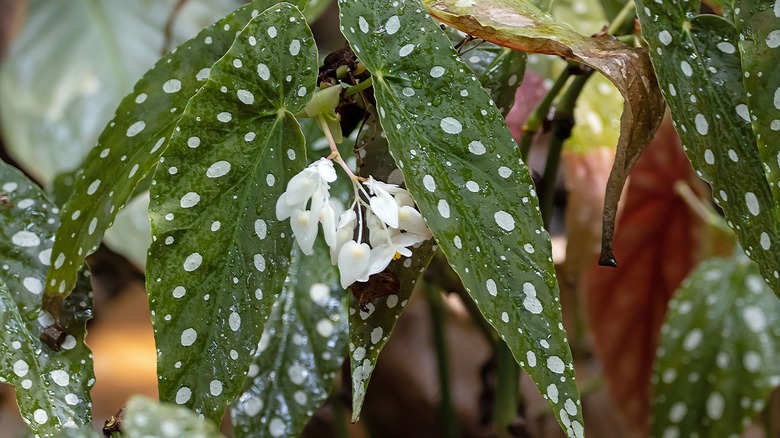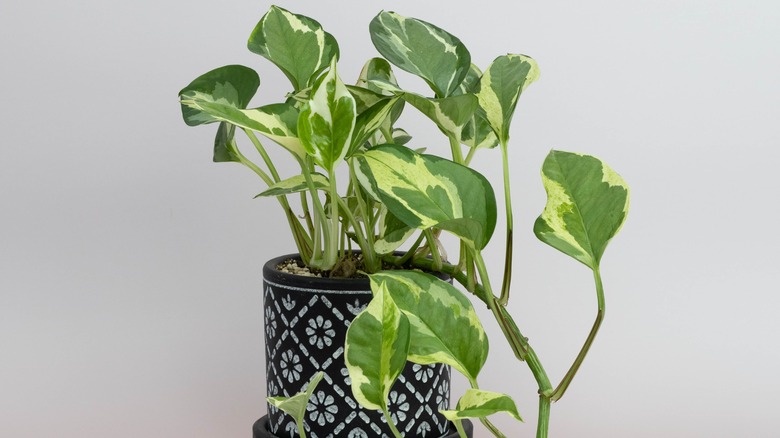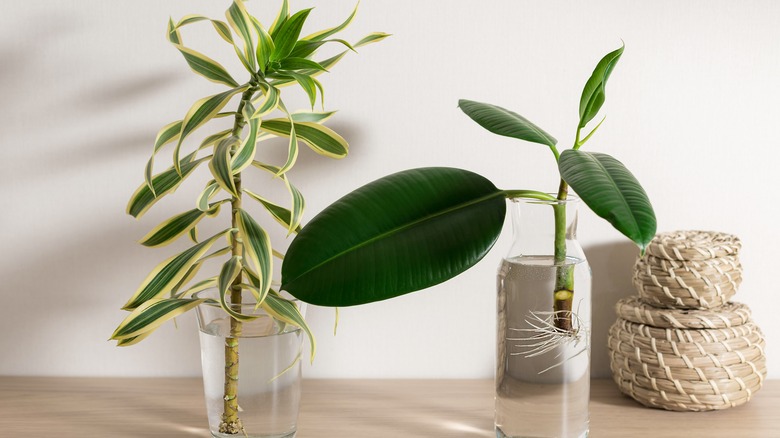12 Pretty Plants That Only Need A Little Bit Of Water To Propagate
Is there anything more tranquil than an indoor jungle? We doubt it. Having lush greenery in your home gives it a certain aesthetic that can make it feel like your own little secret garden. Unfortunately, creating that oasis can get expensive quickly, especially if you want to buy plants that tend to be a little more exotic looking than your standard spider plant. Luckily, there's a solution that lets you grow your houseplant collection without needing to source pricey foliage — propagation.
Propagation essentially means taking pieces off a living plant in order to create new baby plants. There are a few types of propagation, and each method works best for different types of plants. Most houseplant experts consider water propagation to be the easiest for beginners to do since it's low maintenance and is a fast way to establish plant growth. This method is also known as hydroponics, but don't let the scientific name scare you. It's a method you can use right now to save a dying houseplant plant or root a cutting with only a few materials. The most important material, of course, is the plant! But which plant should you pick? Here are a few of our show-stopping favorites.
We love the zebra plant for its contrasting colors
The zebra plant (aphelandra squarrosa) hails from South America and has distinct deep green leaves with white veining. It can grow up to six feet tall and can live up to a decade! They prefer a temperature range between 60 to 70 degrees Fahrenheit, but the plant will have a dormancy period in the winter regardless of the conditions. Since it's a tropical plant, it loves lots of humidity, around 60 to 70%. To propagate the zebra plant, your cutting should have at least one node and will want bright, indirect light to maintain its deep colors. If everything goes right you'll be rewarded with bright yellow bursts of flowers.
Love pink? Try growing the blushing bride tradescantia
The blushing bride tradescantia is a clump-forming hybrid of the spiderwort family. Don't be disappointed if your cutting is pure green in the beginning. Be patient with your propagating plant as new growth will reveal splashes of blush pink accents once it settles in. It can occasionally produce white flowers with bright yellow stamens, too. Tradescantia cuttings can grow in full sun but you should probably keep it in shadier areas to maintain its bright pink colors.
The variegated monstera albo is a highly collectible trendsetter
Not your average monstera, the albo borsigiana variegata is a marvel of genetics. Its white coloring is from a lack of chlorophyll due to a process called "chimeric variegation" which is a fault in the plant's genetic code. This means that no two albos the same, and consequently, quite spendy so propagating them is a major perk. Albos require bright, indirect light to keep their variegation and your cutting must have at least one node to propagate in water. Since it's native to Central America, it does best in temperatures between 65 to 80 degrees Fahrenheit and between 60 to 70% humidity.
The variegated monstera aurea gives the albo a run for its money
Like its albo cousin, the variegated monstera aurea (aurea variegata) is a favorite of exotic houseplant collectors. The aurea has bursts of colors on its leaves ranging from pale to bright yellow which makes it stand out from "normal" white variegations. Despite its different coloring, the aurea has similar care requirements to the variegated albo: it needs bright, indirect light to maintain its yellows and will grow in water if your cutting has at least one node. To maintain and increase this monstera's variegation, make sure it gets enough sunlight. However, too much light can scorch its leaves, so finding balance is key.
The black cherry princess philodendron has incredible pink and black leaves
Want something a little bold? Give the black cherry princess philodendron a try. This is a hybrid of the philodendron melanochrysum and philodendron 'pink princess' and has deep green, almost black leaves with bright pink variegations. Despite its hybrid nature and exotic look, the black cherry is a pretty easygoing plant. It prefers bright, indirect light and thrives in temperatures between 65 to 80 degrees Fahrenheit. Since it's a philodendron, it's one of the easier plants to water propagate, just be sure your cutting doesn't have any leaves sitting in the water because they're susceptible to rot. Philodendrons are climbers and this is no exception so give it a moss pole or trellis once it's rooted in soil to help it reach its full height.
Check out the unique stems of the alocasia zebrina
Hailing from the Philippine rainforests, the alocasia zebrina is one of the few alocasias that can work in water propagation thanks to its moist origins. It's pale white stems (known as "petioles") are flecked with dark brown stripes, giving it the "zebra" of its "zebrina." It has bright green heart-shaped leaves that can even get dark green veining if you happen to pick up the rarer reticulata variation. Zebrinas are sensitive to leaf burn so keep your cutting away from direct sunlight and opt for bright, but indirect light instead. Once it's rooted, your alocasia will need nutrient-rich soil that's well-draining and consistently moist.
The African violet is fussy but its colors are worth the effort
The African violet (saintpaulia ionantha) is one of the easier plants to find on this list; you can pick it up as most big box stores and nurseries. Despite the availability, these violets can be tough to grow successfully, making them better for more experienced plant parents. That said, the payoff of caring for these beauties is well-worth the effort because when happy they'll give off multiple blooms a year. For successful water propagation you cutting should have around two inches of stem which can take up to a month to develop roots. Use a narrow-necked propagation container to ensure no leaves touch the water, which can cause it to rot.
The alocasia nebula is out of this world
The alocasia nebula (alocasia scabriuscula) is full of surprises. The colorings of a mature plant can include marbling in shades of green, black, purple, or even silver which can give off some truly out-of-this-world vibes, hence the "nebula" in its name. If you're lucky enough to get your hands on the rare Imperialis cultivar, you'll notice leaves that have a skeletal, monochromatic look that could appear in a scene of "The Nightmare Before Christmas." To propagate your alocasia zebrina, keep your water-filled jar in bright, indirect light and maintain temperatures between 60 to 85 degrees Fahrenheit.
Aglaonema pictum tricolor looks like camouflage
From the family commonly known as "Chinese evergreens" the aglaonema pictum tricolor plant has a very cool camouflage pattern with varying shades of green on its leaves. Aglaonemas are overall easy-to-care-for plants that do well in water propagation. Since the pictum tricolor is mostly shades of green, it can grow in darker conditions than its brightly-colored cousins but should get at least six to eight hours of indirect light per day. If cared for properly, you should expect to see new roots develop within three to four weeks.
The watermelon peperomia is a great plant for beginners
The watermelon peperomia (peperomia argyreia) is an excellent plant for those who are just getting into water propagation. This plant comes from the forest floors of South America and has leaves that look like the skin of a watermelon. They don't grow too big, maxing out around twelve inches, and are not considered toxic for pets or humans, making them great for most locations in your home. It can even handle low-light conditions and medium-to-low humidity, which is why you might find them in offices. That said, your cutting should be placed in bright, indirect light at first to encourage root growth. Make sure it has at least one leaf on its stem, too, so that it's easy for the plant to photosynthesize.
The polka dot begonia is a rare succulent that can handle water propagation
The polka dot begonia (begonia maculata) has striking elongated leaves that have sprays of white polka dots that range from gray to silver. This succulent comes from tropical regions around the world and can grow up to three feet tall when it's happy. To propagate in water, expert gardeners recommend taking a cutting when it has very few flowers on the mother plant, typically in the winter. The maculata is slow to root when propagating, so you'll need to be patient. You should expect it to take up to two months before roots develop that are strong enough to handle being transplanted into soil.
The pearls and jade pothos has a secret that makes propagation easy
The pearls and jade pothos (epipremnum aureum) is a gorgeous cultivar with thin leaves that are rimmed with white or green. Pothos are not only incredibly easy to care for but have a secret weapon that many plant lovers use to boost other propagations. The plant actually has two natural rooting hormones (auxin and cytokinins) that can help slower-growing plants get a little boost just by sharing the same propagation glass. Just make sure your aureum cutting has at least one leaf to ensure propagation success.
Tips for propagating plants in water
Before you start hacking away your houseplants, there are a few things you should know to ensure water propagation success. First, let your cutting develop a callus over the fresh cut for a few hours before dunking it in water. You can either leave it out in the air to callous naturally or dip the end into melted wax. This helps prevent the stem from rotting. Next, make sure you change the water out every few days. Root growth requires oxygen and still water loses oxygen over time. You can also add a few drops of hydrogen peroxide to help cuttings benefit from steadier oxygenation levels. Finally, make sure your cutting has at least one leaf on the top (above the water) and node. The node is where the roots will come from while the leaf will collect the light your cutting needs to photosynthesize.
